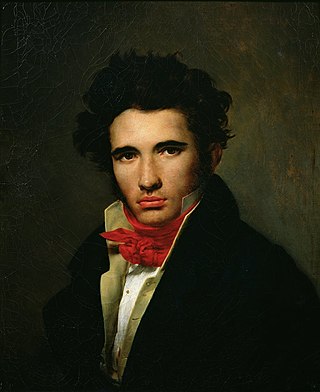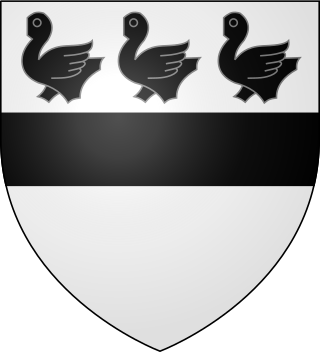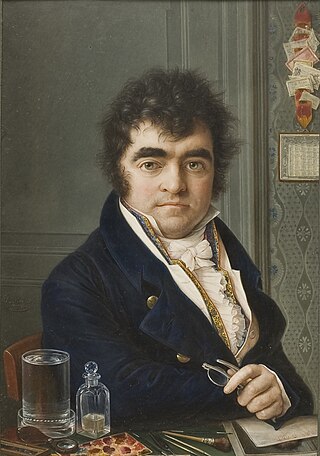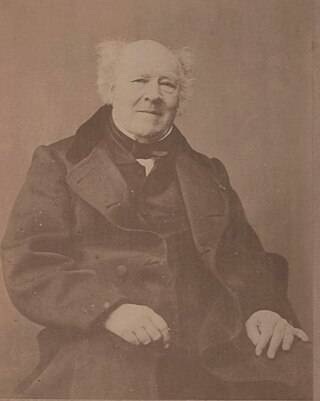Louis Hersent | |
|---|---|
 Self-portrait, 1848 | |
| Born | 10 March 1777 Paris, France |
| Died | 2 October 1860 (aged 83) |
| Resting place | Père Lachaise Cemetery |
| Occupation | Painter |
Louis Hersent (10 March 1777 – 2 October 1860) [1] was a French painter.
Louis Hersent | |
|---|---|
 Self-portrait, 1848 | |
| Born | 10 March 1777 Paris, France |
| Died | 2 October 1860 (aged 83) |
| Resting place | Père Lachaise Cemetery |
| Occupation | Painter |
Louis Hersent (10 March 1777 – 2 October 1860) [1] was a French painter.
He was born in Paris. He became a pupil of Jacques-Louis David, and obtained the Prix de Rome in 1797. In the Salon of 1802, he showed Metamorphosis of Narcissus, and he continued to exhibit with rare interruptions up to 1831. [1] He married Louise-Marie-Jeanne Mauduit in 1821.
His pupils were Louis-Eugène Bertier, Auguste Bigand, Hélène Charlotte Juliette de Bourge, Augustin Luc Demoussy, Henri Joseph Constant Dutilleux, Hippolyte Dominique Holfeld, Jean-Francois-Hyacinthe-Jules Laure, Eugène Modeste Edmond Lepoittevin, Emile Aubert Lessore, Auguste Dominique Mennessier, François Alexandre Pernot, Julie Philipault, August Thomas Pierre Philippe, Pierre Poterlet, Joachim Sotta, Henry de Triqueti, and Théophile Auguste Vauchelet. [2] His most considerable works under the First French Empire were Achilles parting from Briseis, and Atala dying in the arms of Chactas (both engraved in Landon's Annales du Musée); an Incident of the life of Fénelon, painted in 1810, found a place at Malmaison, and Passage of the Bridge at Landshut, which belongs to the same date, is now at Versailles. [1]
Hersent's typical works, however, belong to the period of the Restoration; Louis XVI relieving the Afflicted (Versailles) and Daphnis and Chloë (engraved by Laugier and by Gelée) were both in the Salon of 1817; at that of 1819 the Abdication of Gustavus Vasa brought to Hersent a medal of honour, but the picture, purchased by the Duke of Orléans, was destroyed at the Palais-Royal in 1848, and the engraving by Henriquel-Dupont is now its sole record. Ruth, produced in 1822, became the property of Louis XVIII, who from the moment that Hersent rallied to the Restoration patronized him, made him officer of the Legion of Honour, and pressed his claims at the Institut de France (Académie des Beaux-Arts), where he replaced van Spaendonck. [1]
He continued in favour under Charles X, for whom was executed Monks of Mount St Gotthard, exhibited in 1824. In 1831, Hersent made his last appearance at the Salon with portraits of Louis Philippe, Marie Amélie and the duke of Montpensier; that of the kingwas not considered by the anonymous author in the Encyclopædia Britannica Eleventh Edition as equal to the portrait of Spontini (Berlin), which the author considered probably Hersent's chef-d'œuvre. [1]
After this date, Hersent ceased to exhibit at the yearly salons. Although in 1846 he sent a likeness of Delphine Gay and one or two other works to the rooms of the Société d'Artistes, he could not be tempted from his usual reserve even by the international contest of 1855. [1]

Marc Gabriel Charles Gleyre, was a Swiss artist who was a resident in France from an early age. He took over the studio of Paul Delaroche in 1843 and taught a number of younger artists who became prominent, including Henry-Lionel Brioux, George du Maurier, Claude Monet, Pierre-Auguste Renoir, Louis-Frederic Schützenberger, Alfred Sisley, Auguste Toulmouche, and James Abbott McNeill Whistler.

Jean-Baptiste Isabey was a French painter born in Nancy, France. He was a successful artist, both under the First Empire and to the diplomats of the Congress of Vienna.

Anne-Louis Girodet de Roussy-Trioson, also known as Anne-Louis Girodet-Trioson or simply Girodet, was a French painter and pupil of Jacques-Louis David, who participated in the early Romantic movement by including elements of eroticism in his paintings. Girodet is remembered for his precise and clear style and for his paintings of members of the Napoleonic family.

Ary Scheffer was a Dutch-French Romantic painter. He was known mostly for his works based on literature, with paintings based on the works of Dante, Goethe, and Lord Byron, as well as religious subjects. He was also a prolific painter of portraits of famous and influential people in his lifetime. Politically, Scheffer had strong ties to King Louis Philippe I, having been employed as a teacher of the latter's children, which allowed him to live a life of luxury for many years until the French Revolution of 1848.

Baron François Joseph Bosio was a Monegasque sculptor who achieved distinction in the first quarter of the nineteenth century with his work for Napoleon and for the restored French monarchy.

François Joseph Heim was a French painter known especially for his history paintings and portraits.

Léon Cogniet was a French history and portrait painter. He is probably best remembered as a teacher, with more than one hundred notable students.
Events in the year 1824 in Art.

François Pascal Simon Gérard, titled as Baron Gérard in 1809, was a prominent French painter. He was born in Rome, where his father occupied a post in the house of the French ambassador, and his mother was Italian. After he was made a baron of the Empire in 1809 by Emperor Napoleon, he was known formally as Baron Gérard.

Pauline Auzou was a French painter and art instructor, who exhibited at the Paris Salon and was commissioned to make paintings of Napoleon and his wife Marie Louise, Duchess of Parma.

Eugène François Marie Joseph Devéria was a French Romantic history painter, portraitist and muralist.

The House of Beauharnais is a French noble family. It is now headed by the Duke of Leuchtenberg, descendant in male line of Eugène de Beauharnais.

The Musée de la Vie romantique stands at the foot of Montmartre hill in the 9th arrondissement of Paris, 16 rue Chaptal, Paris, France in an 1830 hôtel particulier facing two twin-studios, a greenhouse, a small garden, and a paved courtyard. The museum is open daily except Monday. Permanent collections are free. An admission fee is charged for temporary exhibitions. The nearest métro stations are Pigalle, Blanche, Saint-Georges, and Liège.

Louis Pierre Henriquel-Dupont was a French engraver. His students included Charles Bellay, Jean-Baptiste Danguin, Adrien Didier, Alphonse and Jules François, Adolphe-Joseph Huot, Achille and Jules Jaquet, Jules Gabriel Levasseur, Aristide Louis, Louis Marckl, Isidore-Joseph Rousseaux, Abel Mignon and Charles Albert Waltner.

Louis-Marie Autissier, was a French-born Belgian portrait miniature painter. According to Marjorie E. Wieseman, curator of European painting, at the Cincinnati Art Museum, "Autissier's success as a miniaturist was in large measure due to his talent as a colourist and his meticulous detailing of costumes and accessory." He is considered the founder of the Belgian school of miniature painting in the nineteenth century. Among his most accomplished pupils and followers were Alexandre de Latour (1780–1858), Louis Henri de Fontenay, and Dominique Ducaju (1802–1867). His works are in the collections of the Cincinnati Art Museum, the Nationalmuseum and the Royal Collection.
Alexis Leon Louis Valbrun was a prominent French painter specialized in portraits of the European aristocracy. He studied under Nicolas Gosse and was a pupil of Antoine-Jean Gros. He entered the École nationale supérieure des Beaux-Arts in Paris in 1817 and exhibited his work at the Salon between 1831 and 1843. Some of his paintings are displayed at the Fondation Calvet in Avignon, the Palace of Versailles and the Chateau de Chantilly. His historic painting La mort de Saphire was exhibited at the Salon in 1843. In 1846 he decorated the church Saint-Paul-Saint-Louis in Paris.

Louise Marie-Jeanne Hersent-Mauduit was a French oil painter, primarily of portraits and historical scenes.

Auguste-François Michaut was a French coin engraver of France and Holland, a medallist and sculptor.

Eugène Roger was a French painter in the Romantic style who specialized in historical and Biblical scenes.
Philippe Poitevin was a French sculptor.
![]() Media related to Louis Hersent at Wikimedia Commons
Media related to Louis Hersent at Wikimedia Commons